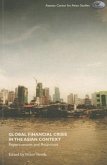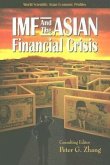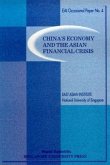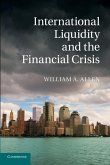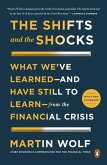The first theoretical analysis of the Asian financial crisis, perhaps the single most important economic event of the 1990s.
Presents the first theoretical analysis of the Asian financial crisis and draws out the general lessons of an event whose potential long term effects have been likened to those of the Crash of 1929. Part I presents a factual and analytic overview of what happened: the role of 'vulnerability'; the interconnection between currency crises and financial crises; and why crisis turned into collapse. Part II considers more detailed issues, including how the inflation of non-traded goods prices created vulnerability, welfare-reducing capital inflow owing to under-regulated financial markets, and the onset of speculative attacks. Part III assesses all aspects of contagion, in particular the role of geographic proximity. The final section addresses policy issues. Joseph Stiglitz argues that there is much that can be done to reduce the frequency of crises and to mitigate the severity of crises when they happen. The book finishes with a round-table discussion of policy issues.
Table of contents:
List of figures; List of tables; Preface; Acknowledgements; Introduction Pierre-Richard Agénor, Marcus Miller, David Vines and Axel A. Weber; Part I. General Accounts: 1. The role of macroeconomic and financial sector linkages in East Asia's financial crisis Pedro Alba, Amar Bhattacharya, Stijn Claessens, Swati Ghosh and Leonardo Hernandez; Discussion Sule Ozler; 2. The Asian crisis: lessons from the collapse of financial systems, exchange rates and macroeconomic policy Jenny Corbett and David Vines; Appendix: Thailand, a stylised chronology; Discussion Christopher Bliss; 3. Are capital inflows to developing countries a vote for or against economic policy reforms? Michael P. Dooley; Discussion Kenneth Kletzer; 4. The Asian crisis: an overview of the empirical evidence and policy debate Giancarlo Corsetti, Paolo Pesenti, and Nouriel Roubini; Appendix; Discussion Richard Portes; Part II. Theoretical Contributions: 5. Capital markets and the instability of open economies Philippe Aghion, Philippe Bacchetta and Abhijit Banerjee; Appendix 1: solving the model in the Leontief case; Appendix 2: why full financial liberalisation - unlike foreign direct investment - may destabilise an emerging market economy; Discussion Gianluca Femminis; 6. Volatility and the welfare costs of financial market integration Pierre-Richard Agénor and Joshua Aizenman; Discussion John Driffill; 7. A theory of the onset of currency attacks Stephen Morris and Hyun Song Shin; Discussion Jonathan P. Thomas; Part III. Contagion: 8. Contagion: monsoonal effects, spillovers and jumps between multiple equilibria Paul Masson; Discussion Axel A. Weber; 9. Contagion and trade: why are currency crises regional? Reuven Glick and Andrew K. Rose; Appendix; Discussion Mark P. Taylor; 10. Competition, complementarity and contagion in East Asia Ishac Diwan and Bernard Hoekman; Appendix; Discussion Jenny Corbett and David Vines; Part IV. Policy Responses: 11. Coping with crises: is there a 'silver bullet'? Amar Bhattacharya and Marcus Miller; 12. Must financial crises be this frequent and this painful? Joseph Stiglitz; 13. Round table discussion Richard Portes, Phillip Turner and Charles A. Goodhart; Index.
Presents the first theoretical analysis of the Asian financial crisis and draws out the general lessons of an event whose potential long term effects have been likened to those of the Crash of 1929. Part I presents a factual and analytic overview of what happened: the role of 'vulnerability'; the interconnection between currency crises and financial crises; and why crisis turned into collapse. Part II considers more detailed issues, including how the inflation of non-traded goods prices created vulnerability, welfare-reducing capital inflow owing to under-regulated financial markets, and the onset of speculative attacks. Part III assesses all aspects of contagion, in particular the role of geographic proximity. The final section addresses policy issues. Joseph Stiglitz argues that there is much that can be done to reduce the frequency of crises and to mitigate the severity of crises when they happen. The book finishes with a round-table discussion of policy issues.
Table of contents:
List of figures; List of tables; Preface; Acknowledgements; Introduction Pierre-Richard Agénor, Marcus Miller, David Vines and Axel A. Weber; Part I. General Accounts: 1. The role of macroeconomic and financial sector linkages in East Asia's financial crisis Pedro Alba, Amar Bhattacharya, Stijn Claessens, Swati Ghosh and Leonardo Hernandez; Discussion Sule Ozler; 2. The Asian crisis: lessons from the collapse of financial systems, exchange rates and macroeconomic policy Jenny Corbett and David Vines; Appendix: Thailand, a stylised chronology; Discussion Christopher Bliss; 3. Are capital inflows to developing countries a vote for or against economic policy reforms? Michael P. Dooley; Discussion Kenneth Kletzer; 4. The Asian crisis: an overview of the empirical evidence and policy debate Giancarlo Corsetti, Paolo Pesenti, and Nouriel Roubini; Appendix; Discussion Richard Portes; Part II. Theoretical Contributions: 5. Capital markets and the instability of open economies Philippe Aghion, Philippe Bacchetta and Abhijit Banerjee; Appendix 1: solving the model in the Leontief case; Appendix 2: why full financial liberalisation - unlike foreign direct investment - may destabilise an emerging market economy; Discussion Gianluca Femminis; 6. Volatility and the welfare costs of financial market integration Pierre-Richard Agénor and Joshua Aizenman; Discussion John Driffill; 7. A theory of the onset of currency attacks Stephen Morris and Hyun Song Shin; Discussion Jonathan P. Thomas; Part III. Contagion: 8. Contagion: monsoonal effects, spillovers and jumps between multiple equilibria Paul Masson; Discussion Axel A. Weber; 9. Contagion and trade: why are currency crises regional? Reuven Glick and Andrew K. Rose; Appendix; Discussion Mark P. Taylor; 10. Competition, complementarity and contagion in East Asia Ishac Diwan and Bernard Hoekman; Appendix; Discussion Jenny Corbett and David Vines; Part IV. Policy Responses: 11. Coping with crises: is there a 'silver bullet'? Amar Bhattacharya and Marcus Miller; 12. Must financial crises be this frequent and this painful? Joseph Stiglitz; 13. Round table discussion Richard Portes, Phillip Turner and Charles A. Goodhart; Index.


